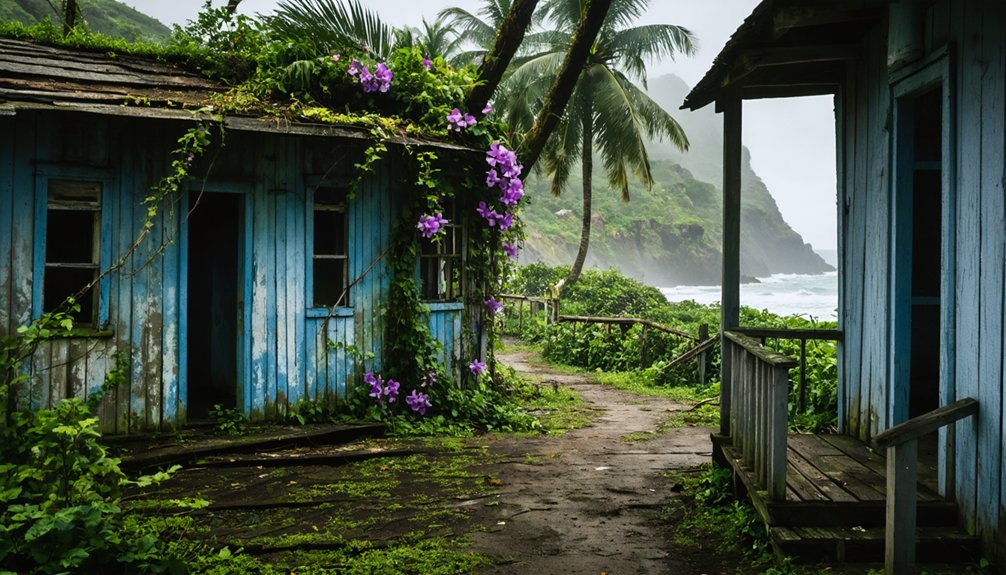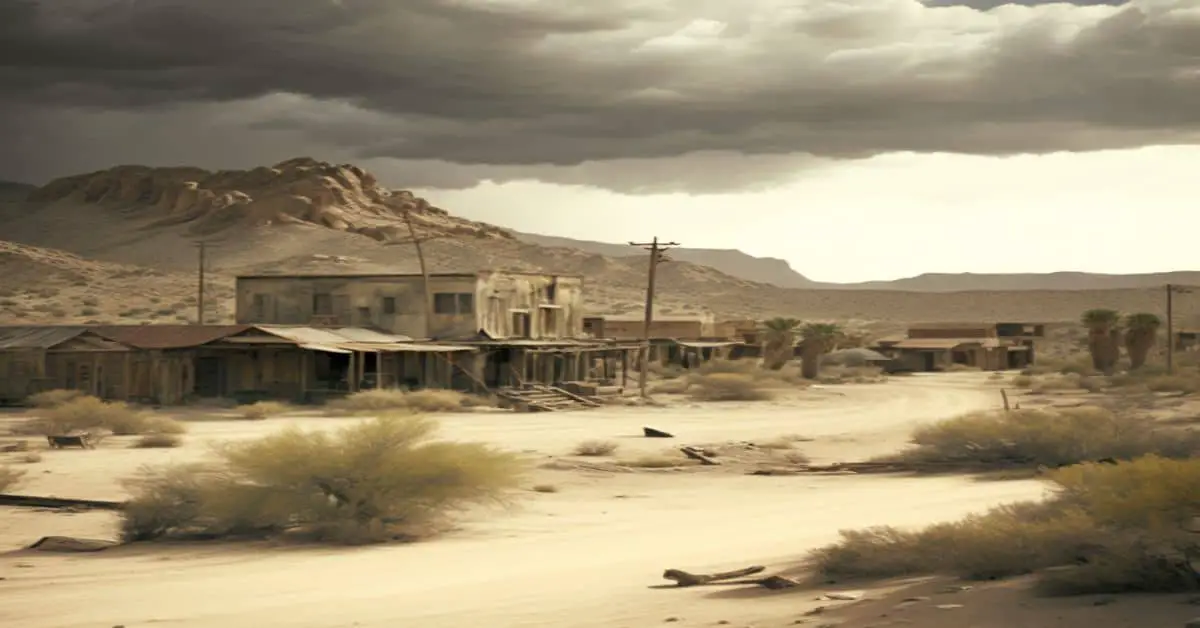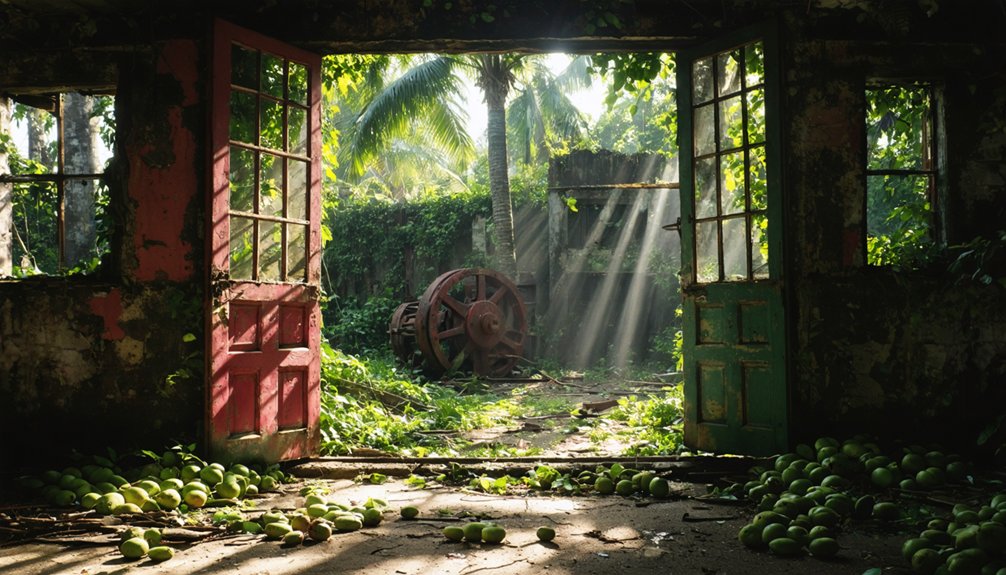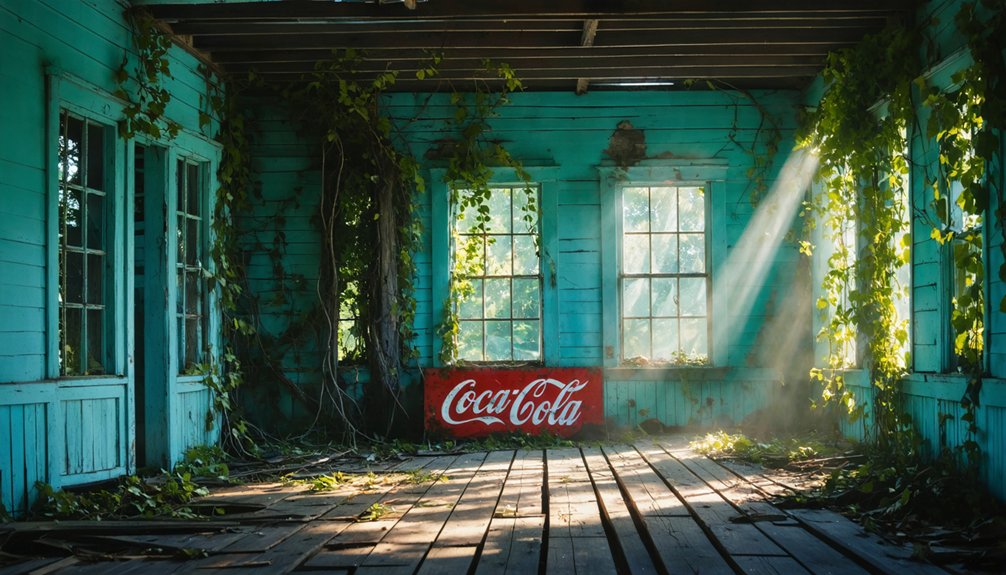You’ll find Kalawao’s haunting remnants on Molokai’s isolated peninsula, where over 8,500 leprosy patients were exiled beginning in 1865. Under King Kamehameha V’s quarantine policies, this forced settlement endured desperate conditions until Father Damien’s arrival in 1873 brought hope through improved housing and infrastructure. Today, preserved churches, building foundations, and cemeteries tell stories of struggle and resilience, while nature slowly reclaims this sacred ground that holds countless untold histories.
Key Takeaways
- Kalawao became a leprosy settlement in 1865, forcing over 8,500 patients into isolation on Molokai’s remote peninsula.
- The former colony now stands largely abandoned, with historic structures including St. Philomena Church and remnants of patient housing.
- Father Damien transformed the settlement between 1873-1889, building infrastructure and providing spiritual leadership to the isolated community.
- The site is now preserved as Kalaupapa National Historical Park, protecting both historical buildings and natural landscapes.
- Nature gradually reclaims the ghost town’s structures, while architectural foundations and cemeteries remain as testament to its past.
The Birth of a Forced Paradise
While the Hawaiian islands were known for their natural beauty and rich cultural heritage, Kalawao’s transformation into a leprosy colony in 1865 marked one of the darkest chapters in Hawaii’s history.
Under King Kamehameha V’s quarantine policies, the government forcibly evicted Native Hawaiian families who’d cultivated these lands for generations. You’ll find historical significance in how the Board of Health legally declared over 8,500 leprosy patients as “dead” upon their exile to this isolated peninsula.
The first arrivals in 1866 faced desperate conditions – no proper housing, limited medical care, and unreliable food supplies. Despite the original vision of patient self-sufficiency using abandoned Hawaiian homes, many were too ill or dispirited to maintain agricultural practices, leading to severe hardship in this forced paradise. Compassionate family members voluntarily joined their loved ones as kokua helpers, choosing isolation over separation. The site sits dramatically at the base of 2,000-foot sea cliffs, creating a natural barrier that enhanced the isolation of its residents.
Life Under Quarantine
Life in Kalawao’s quarantine settlement revealed the harsh realities of isolation policies and their profound impact on those affected. You’d have found yourself facing severe quarantine challenges, from inadequate infrastructure to limited medical care.
Basic supplies were often tossed overboard due to the lack of proper docking facilities, leaving you to struggle for survival. Father Damien’s arrival in 1873 brought transformation as he helped build homes, a church, and essential infrastructure. Early missionaries often blamed racial inferiority for the spread of leprosy among native Hawaiians.
Without proper ports, essential supplies were hurled into the waves, forcing the isolated community to fight daily for basic necessities.
The isolation effects extended far beyond physical hardships. You’d witness the emergence of survival-based social hierarchies as the colony’s population grew to 1,200 residents.
Yet, amidst these difficulties, you’d find strength in the community’s resilience. Family members chose to accompany their loved ones as kokua (helpers), while healthcare facilities gradually improved through humanitarian efforts.
Despite the oppressive circumstances, the spirit of ohana (family) and mutual support helped sustain the community through decades of separation.
Father Damien’s Legacy
When you visit Kalawao today, you’ll find Father Damien’s profound legacy woven into the very fabric of this historic settlement, from the Saint Philomena Church he helped build to the improved roads and buildings that remain standing.
His tireless work transformed a place of despair into a community of dignity, where residents learned farming, music, and self-sufficiency while receiving both spiritual and medical care. After arriving in 1873, he was so beloved that the residents petitioned for permanency within just two days. He established the Christian Burial Association to ensure proper and respectful burials for those who died in the colony.
Father Damien’s eventual canonization as Saint Damien of Molokai in 2009 formally recognized what the Hawaiian people had long known – that his selfless service and sacrifice for the ostracized changed countless lives and continues to inspire compassionate care for marginalized communities worldwide.
A Life of Service
After joining the Congregation of the Sacred Hearts of Jesus and Mary in 1858, Father Damien commenced on a path that’d transform both his life and the lives of countless others in Hawaii.
You’ll find his spiritual growth reflected in his early ministry, arriving in Honolulu in 1864 and serving first in Puna, then Kohala and Hamakua on the Big Island. His dedication to community resilience became evident through his eight years of service before his legendary work in Kalawao began.
During this formative period, he’d develop the skills and determination that would later help him transform a place of isolation into one of hope. He devoted himself to building houses and infrastructure for the settlement’s inhabitants. As the first volunteer priest at Kalaupapa, he arrived on May 10, 1873 to begin his life-changing mission.
His ordination in Honolulu marked the beginning of a mission that would ultimately define his legacy as a beacon of compassionate service in Hawaiian history.
His Impact Today
Despite the passage of time since Father Damien’s death in 1889, his profound impact continues to resonate throughout Hawaii and beyond. You’ll find his legacy in the cultural exchange he fostered between different faith communities and the infrastructure he developed, which laid the foundation for lasting community resilience in Kalawao. One recent tribute is the Tree of Hope Tour, which brings his sacred relics to churches across America.
Today, you can witness his enduring influence through the preservation of historical sites he established, including homes and schools that served as keystones of the settlement. His incredible service is commemorated by a statue in Capitol building representing the state of Hawaii. His canonization in 2009 and the annual Father Damien Day celebrations on April 15 keep his memory alive.
Most importantly, you’ll discover his spirit in the ongoing educational programs and cultural events that honor both his humanitarian work and the remarkable strength of Kalawao’s residents.
The Struggle for Basic Resources
The struggle for basic survival defined daily life in Kalawao, where residents faced severe shortages of water, food, and medical supplies. Resource scarcity stemmed from forced relocation policies that disrupted traditional Hawaiian fishing villages and agricultural systems.
Despite these infrastructure struggles, community resilience emerged through Father Damien’s innovative water system built from volcanic rock.
Your understanding of daily hardships deepens when you consider:
- Water had to be collected from limited rainfall or transported across treacherous cliffs.
- Rocky soil and wild hogs made farming nearly impossible without extensive fencing.
- Medical supplies arrived sporadically, if at all, leaving residents without basic care.
- Traditional food sources were lost when native villages were seized for colony expansion.
These challenges created lasting nutritional deficiencies and profound cultural impacts that shaped Kalawao’s tragic history.
Daily Life in the Colony
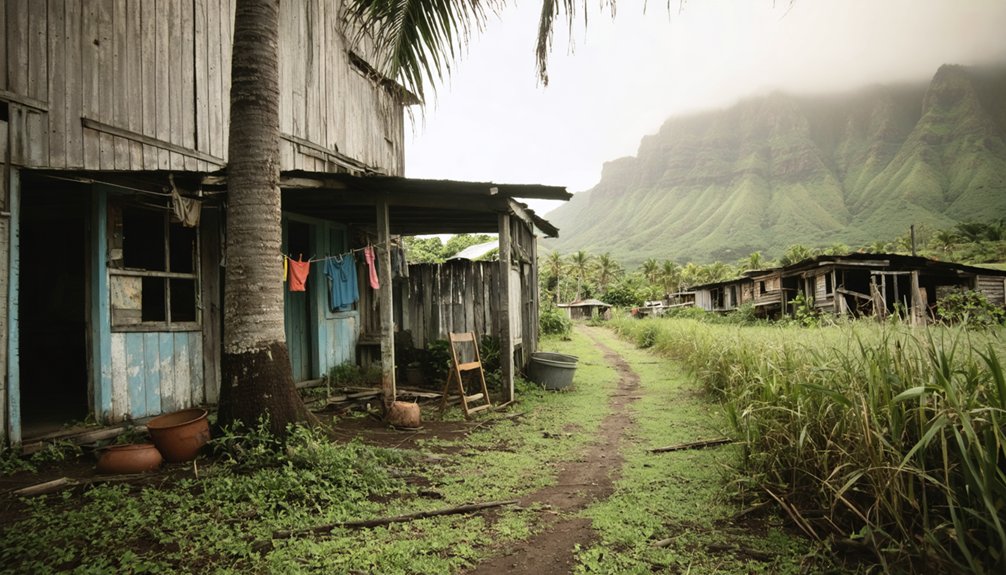
Life within Kalawao’s isolated colony revolved around a complex social structure where patients, kokua (helpers), and religious leaders worked together to build a functioning community.
You’d find residents taking on distinct community roles based on their capabilities – healthier patients helping those who were less able, while kokua provided essential caregiving support.
Your daily routines would have centered around practical tasks: protecting gardens from wild hogs using volcanic rock walls, maintaining crude housing structures, and managing water systems.
The church, led by figures like Father Damien, offered both spiritual guidance and practical leadership.
Despite harsh conditions and geographic isolation, you’d witness a remarkable system of mutual aid emerge, where residents worked together to improve their settlement while maintaining deep spiritual connections to the land through traditional Hawaiian beliefs.
Voices From the Past
Through preserved letters, records, and oral histories housed at Kalaupapa National Historical Park, you’ll encounter firsthand accounts of those who endured life in Kalawao’s isolation settlement.
You’ll read of families torn apart, daily struggles for basic necessities, and the profound emotional toll of forced separation from loved ones.
Yet within these personal narratives, you’ll also discover stories of remarkable resilience, as residents created meaningful lives and built lasting relationships despite their harsh circumstances.
Surviving Letters and Records
While Kalawao’s physical structures have largely faded into history, a rich collection of personal letters, official documents, and photographs continues to give voice to those who lived within its boundaries.
Through careful archival preservation, you’ll find historical correspondence that reveals intimate details of daily life, spiritual reflections, and administrative decisions that shaped the settlement.
These preserved voices speak through:
- Letters from patients describing their personal struggles and experiences
- Father Damien and Brother Dutton’s missionary accounts detailing community care
- Official Hawaiian government records documenting policies and census data
- Church archives containing sermons, baptismal records, and parishioner correspondence
In the Hawaiʻi State Archives and National Park Service collections, these documents provide lasting testimony to the human spirit that flourished within Kalawao’s bounds.
Life Through Their Eyes
Personal narratives preserved in letters and records paint vivid portraits of Kalawao’s daily realities, where survival meant more than just enduring physical hardship.
You’ll find stories of remarkable community resilience as residents transformed their exile into a functioning society. They built protective rock walls, developed water systems, and maintained cultural practices despite their isolation. Through their words, you’ll discover how they formed an ‘ohana, supporting one another through shared grief and determination.
Their cultural adaptation shines through accounts of collaborative building projects and communal farming efforts. While their letters reveal the deep psychological wounds of forced separation and stigma, they also tell of unwavering hope.
Under the leadership of figures like Father Damien and Mother Marianne, residents created a self-sufficient community that honored their Hawaiian heritage while facing unprecedented challenges.
Stories of Daily Hardship
Letters and diaries from Kalawao’s early settlers reveal harrowing accounts of daily survival against seemingly insurmountable odds.
Through their words, you’ll witness the raw emotional resilience required to face each day in this isolated peninsula, where survival strategies evolved from desperation to determination.
Consider these stark realities they faced:
- You’d wake to find no clean water, forcing dangerous climbs down steep cliffs to gather what you could.
- You’d struggle to build makeshift shelters from whatever materials nature provided.
- You’d watch helplessly as fellow exiles succumbed to illness without proper medical care.
- You’d learn to fish in shark-infested waters, knowing each catch meant another day of survival.
Despite being legally declared dead by the Kingdom of Hawaii, these settlers refused to surrender their spirit, forming tight-knit communities that shared both burdens and hope.
Architectural Remnants
Today’s architectural remnants of Kalawao offer poignant glimpses into the settlement’s past through extensive building foundations, two historic churches, and scattered cemeteries.
You’ll find St. Philomena Catholic Church and Siloama Congregationalist Church standing as the only original 19th-century structures, their mission-style architectural styles reflecting the simple dignity of the era.
Along Damien Road, you can trace the settlement’s layout through remaining foundations where Father Damien helped construct hundreds of homes.
These architectural elements reveal a blend of traditional Hawaiian and colonial influences, challenging historical stigmas through archaeological evidence.
While most wooden buildings have surrendered to time, the foundations and churches maintain deep historical significance, preserving the memory of a community that once called this place home.
Nature Reclaims Kalawao
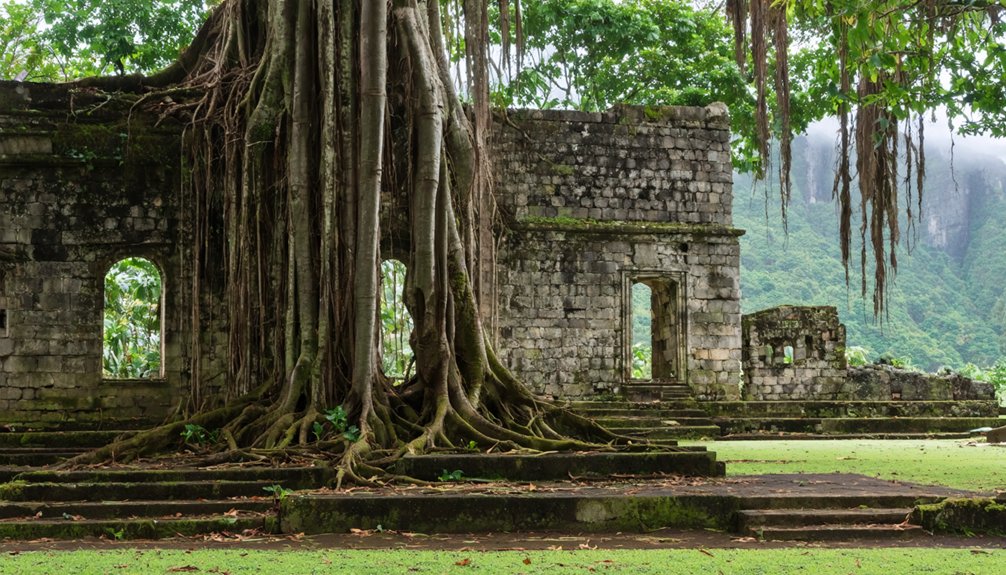
While human activity in Kalawao has greatly diminished, nature’s resilience transforms the historic settlement through a gradual reclamation process.
You’ll witness nature’s determined restoration of this sacred ground, where ecological challenges from years of isolation are slowly being overcome.
Throughout the area, you’ll observe:
- Native vegetation pushing through abandoned structures where fewer than 10 former patients now reside
- Feral ungulates roaming freely, requiring careful management to protect indigenous resources
- Valley streams continuing their ancient flow, sustaining the land as they did for generations
- Traditional taro cultivation areas slowly returning to their natural state
The ongoing conservation efforts honor both the land’s historical significance and its ecological restoration, preserving Kalawao’s cultural heritage while allowing nature to heal the landscape.
The Sacred Ground Today
Sacred and solemn, Kalawao stands as a memorial to the thousands who lived and died in isolation on Molokai’s remote peninsula.
Today, you’ll find this hallowed ground under the careful stewardship of multiple authorities, including the Hawaii Department of Health and National Park Service, who protect its cultural significance and sacred memorials.
While eight elderly Hansen’s disease registry patients remain alive, some still residing in the area, you can’t freely visit this historic site.
The law strictly controls access to preserve the dignity of these survivors and their ancestors.
Over 8,000 people, primarily Native Hawaiians, were exiled here between 1866 and 1969.
Their story lives on in the ruins of hospitals and churches, now embraced by nature, serving as powerful reminders of their sacrifice and strength.
Frequently Asked Questions
What Was the Mortality Rate During the First Five Years?
You’ll find that 46% of exiled patients died within their first five years, as harsh conditions, inadequate medical care, and forced separation from family severely impacted all age groups and demographics.
Are There Any Descendants of Kalawao Residents Still Living Today?
You’d be amazed – descendants of Kalawao residents are indeed living today, actively preserving their ancestral stories through genealogical records, cultural programs, and community events that honor their historical impact.
How Did Patients Communicate With Their Families on Other Islands?
You’ll find patients primarily relied on letter writing, with church missionaries delivering messages between islands. They’d also communicate through kōkua helpers and receive updates during rare religious gatherings.
What Happened to the Personal Belongings of Deceased Patients?
When you passed away, your personal effects were either shared among community members or stored. Today, many surviving items serve as historical artifacts in Kalaupapa National Historical Park’s collections.
Did Any Patients Successfully Escape and Return to Their Communities?
Patient stories show no verified successful escapes. While you’ll find tales of attempted freedom through perilous paths and treacherous trails, Kalawao’s natural barriers and social stigma prevented lasting returns.
References
- https://www.nps.gov/kala/learn/historyculture/a-brief-history-of-kalaupapa.htm
- https://en.wikipedia.org/wiki/Kalawao
- https://hawaii.com/kalaupapa-kalawao/
- https://www.dark-tourism.com/index.php/761-kalaupapa-molokai-hawaii
- https://www.britannica.com/place/Kalawao
- http://freepages.rootsweb.com/~gtusa/history/usa/hi.htm
- https://en.wikipedia.org/wiki/List_of_ghost_towns_in_Hawaii
- https://www.pacifichistoricparks.org/history/kalaupapa
- https://www.oha.org/wp-content/uploads/RPT_Kalawao-County.pdf
- https://en.wikipedia.org/wiki/Kalaupapa
